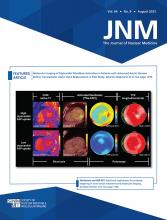TO THE EDITOR: Regarding “Adverse Clinical Events at the Injection Site Are Exceedingly Rare After Reported Radiopharmaceutical Extravasation in Patients Undergoing 99mTc-MDP Whole-Body Bone Scintigraphy: A 12-Year Experience” (1), I read this article with some interest from a purely scientific perspective. I am concerned that the results reported might be used to justify certain courses of action, or inaction, without the evidence to support these approaches. I have several misgivings about this article.
First, the numbers that have been reported for inclusion in this study are likely to be significantly underestimated. Of the approximately 32,000 scans that the authors examined, they found 118 cases of documented extravasation in the clinical reports, of which only 96 could be followed up. The authors cite other audits of bone scan administrations that quote extravasation rates of around 15%–20% in routine clinical practice. On the basis of the 15%–20% rate, the number of extravasations should have been more like 4,750–6,300 cases in the 12-y cohort. A rate of 15%–20% seems, from my experience, to be not unexpected for some degree of extravasation at the injection site. As the authors have included only patients for whom an extravasation had been noted in the clinical report—a notation that is rarely made—they acknowledge that this could lead to an underestimation of the incidence of extravasation. Indeed, the authors state that “this approach has the possibility [my emphasis] of missing studies in which [a radiopharmaceutical extravasation] occurred but was not documented in the report.” The lack of documentation by the reporting physicians may be because the technologist or nurse injecting the patient did not recognize the extravasation at the time of injection (often due to the low injected volumes used) and, hence, the extravasation was detected only when the scan was acquired some hours later. This is a serious underestimate and tends to undermine the authors’ conclusions.
Second, the authors have little clinical or other follow-up information on extravasations that were not documented (assuming the true incidence of around 5,000–6,000 is correct) and seem to assume that if they did not hear anything from the patient then there was no problem. I propose that it is likely most extravasations will not lead to any significant unintended acute or chronic tissue damage but that just because one does not follow up about extravasation does not mean one has evidence of no extravasation issues. The authors may suggest that, on the basis of my estimates, in a cohort of 5,000–6,000 individuals the authors would likely learn of an adverse event even if there is only the slightest possibility of it. However, in complex, fragmented health-care systems, the feedback between primary-care and secondary or tertiary service providers is often tenuous at best, and many primary-care practitioners may not make a connection between the bone scan performed 1 mo previously and the ongoing issue at the patient’s injection site.
Third, whereas the impact of quantification on clinical interpretation is mentioned in the introduction, little emphasis is given to the fact that any quantitative procedure, such as measuring an SUVmax in a PET scan or a bone scan, or even a glomerular filtration rate estimation based on blood sampling, is invalidated when the entire dose is not delivered into the bloodstream for full mixing and redistribution throughout the body. This is a concern for any nuclear medicine procedure but takes on greater importance in serial studies when monitoring changes in organ function or tumor response.
Finally, as the interest in the use of α-particles for therapy increases, the spectre of issues that arise from an extravasated α-emitting therapeutic radiopharmaceutical injection becomes a consideration. There has already been at least one case report of a skin lesion (squamous cell carcinoma) attributed to an extravasated injection of 223Ra (2). Although molecules and small vectors such as peptides may be able to readily drain from a site of extravasation via the lymphatics, larger biologic agents such as antibodies would be particularly concerning.
Although the authors have presented their data with full disclosure about the methodology used, they would appear to have underestimated the limitations of their approach. Readers could be misled were this article to be quoted as a “definitive reference based on large numbers,” suggesting that extravasations in nuclear medicine procedures are without consequence. It is clear that they are not.
Dale L. Bailey
Royal North Shore Hospital, Sydney, Australia
E-mail: dale.bailey{at}sydney.edu.au
Footnotes
Published online Jun. 29, 2023.
- © 2023 by the Society of Nuclear Medicine and Molecular Imaging.
REFERENCES
- Received for publication March 12, 2023.
- Revision received March 14, 2023.







